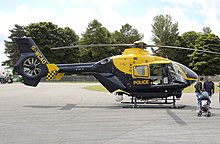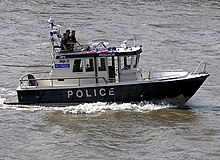Police vehicles in the United Kingdom

Within the British police forces, different types of vehicles are used, mainly depending on the situation, along with the training the driver has received. For example, for community policing a "Panda car" would often be employed. When the fast response to emergency calls is needed a "response car" would often be used, or when attending to a firearms related incident an Armed Response Vehicle would be deployed. In both cases a police van may be necessary for the transportation of suspects. If a police force has a significant waterway that would benefit from policing, such forces will often maintain a sizable Marine Support Unit. Each and every force in the UK has access to a helicopter, often used during pursuit.
Ground vehicles
Incident Response Vehicles (IRV) are generally used when a '999' call has been received about an ongoing incident or emegerency, usually an IRV would be assigned to the call, due to IRVs continually patrolling an area, reducing deployment time. Response vehicles tend to be capable of the safe use of speed, common types include, Ford Focus or Vauxhall Astra. These are usually fitted with engines with a size of around 1.6 to 1.8 litres. Although petrol-powered engines once dominated, diesel engines are now becoming more common due to their superior fuel economy and therefore lower operating costs.
Most response and panda cars, are fitted with a "Runlock" system. This allows the vehicle's engine to be left running without the keys being in the ignition. This enables adequate power, without battery drain, to be supplied to the vehicle's equipment at the scene of a major incident. The vehicle can only be driven off after re-inserting the keys. If the keys are not re-inserted, the engine will switch off if the handbrake is disengaged or the footbrake is activated. Runlock is also commonly used when an officer is required to quickly decamp from a vehicle, by enabling Runlock, the cars engine can be left running without the risk of someone stealing the vehicle, due to the fact that if the vehicle is driven normally the vehicle will shut down, unless runlock system is turned off.
However, as well as response cars, Panda cars are also used within the British Police. These are used to aid in Community policing, due to these vehicles being employed only for patrol. The vehicles commonly used are typically low budget cars, and are not capable of speeding safely to get to an incident.
Larger, more powerful vehicles are used by Road Policing Units, Armed Response Vehicles due to the fact that they carry out tasks such as pursuing stolen cars, responding to emergencies in a larger area, or carrying a larger amount equipment than an IRV. It is for that reason that many of the vehicles are in "estate car" form. These vehicles tend to be Volvo V70 T5's with a 2.4 litre turbocharged petrol engine or Vauxhall Vectras with 3.2 litre V6. As with IRVs, diesel engines are becoming more common such as the BMW 5 Series 3.0 litre diesel which are heavily used by the Metropolitan Police Service. As well as estate cars, 4x4 (SUVs) such as Range Rover, Land Rover Discovery (LR3), BMW X5 or Mercedes M class vehicles are used especially for Motorway patrols. Police Officers are required to undergo specialised training before being authorised to drive them.
Most UK police vehicles are white or silver, although more recently silver becoming more common due to higher resale values after police use is finished, with retroreflective livery markings on the side. These markings usually take the form of a blue, yellow or red strip down the side of the vehicle, or use high visibility battenburg markings (with blue and yellow the accepted Home Office colours for police use). Some carry adverts for police initiatives or slogans such as the Metropolitan Police "Working for a safer London", also some vehicles show the force crest.
Unmarked police vehicles are used on road policing duties. One popular vehicle for this use is the Skoda Octavia VRS which is chosen due to its high performance but conservative styling. Some police forces have begun using Mitsubishi Lancer Evolutions for the most dangerous or challenging car chases. The TVCU (Tactical Vehicle Crime Unit) within the Greater Manchester Police uses cars such as the Audi A3 3.2L Quattro, Mitsubishi Lancer Evolution, and Subaru Impreza WRX. All the TVCU's vehicles are unmarked and have very high performance.
Police vans such as Ford's Transit or Mercedes Sprinter are also used and have a cage for accommodation of a prisoner in the back. Although in the United States it is possible to carry a prisoner or suspect in an ordinary police car, this is not possible in the United Kingdom, as police cars have no a barrier between the front and back seats to protect the officers. Each police force will have different policies in relation to prisoner transportation, some will allow compliant prisoners to be transported in response cars (ensuring that one officer sits in the rear with the prisoner, and the prisoner sits behind the passenger seat). Non-compliant prisoners should always be transported in police vehicles fitted with a cage, some forces mandate all prisoners to be transported in caged vehicles.
Light and siren types
In the police car, a number of controls will exsist to turn on the blue light, and audio functions.
- "Rear-reds" - Is a sequence of flashing red lights, which are usually turned on when the car is stopped at the side of the road, to warn oncoming traffic of its presence.
- "Headlight flash" - Enables the car to flash headlights in a sequence, without using blue lights.
- "Blue lights" - Alternates the light bar on top of the car, to make the presence of the car safe to proceed through parting traffic.
- "Wailer" - Turns on the sirens.
Safe stop tactics
- "Boxing" - The first form of safe stop, several police cars position around the target vehicle, bringing it to a slow, and safe stop, with police vehicles boxing the target vehicle in on all sides.
- Spike strip - Is the second method, if the above is difficult due to the speed or aggressive driving of the target vehicle. Stinger is a sliding rack of spikes that are deployed across a road, to deflate the vehicles tires. This is done safely, due to the spikes being hollow, stopping even the fastest driving car.
- "Tactical Contact" - The third method, is used if the above method is not employed due to the driver taking different directions, rather than one road. This is made possible by the driver performing a PIT maneuver, which is a safe and controlled way of taking the car off of the road. This is achieved by the police car hitting the back end of the target vehicle, in the hope it would spin around and lose traction.
- Road Block - As a last resort, which requires authorisation from the Chief Constable of the force concerned. This being due to the fact that a road block, may cause damages to police vehicles and officers. This is achieved by police cars, blocking off the road in the hope that it would force the vehicle to stop.
Equipment
Area cars (that respond to incidents) and Panda cars (that are mainly used for community policing) may carry:
- First aid kit
- Traffic cone
- Blankets
- Shovel
- Broom
- Breath analysis system
- Speed gun
- Tyre Deflation Device (within Road Policing Units).
- Teddy Bear (some RPU's carry them to console a child after an accident)
- Enforcer, entry gaining device
Aircraft

Most British police forces have access to an aircraft, commonly an EC 135 helicopter, although some forces use the Britten-Norman Islander. Such vehicles are useful for many situations encountered by the police. Aircraft are often employed when searching for reported missing or vulnerable persons, due to the fact that a helicopter can survey the area more quickly and easily than officers on the ground. Also, these aircraft become especially useful in ground vehicle pursuits, most commonly when ground police vehicles have been forced to discontinue a pursuit of a vehicle due to the danger placed on other road users, and obviously, helicopters are under no such restraint.
Police helicopters are equipped with infra-red and nightvision cameras.
Watercraft

Police forces whose area includes significant waterways often include Marine Support Units. Not only do these units police the waterways, but they also maintain a capability for waterborne rescue, usually in cooperation with the RNLI.
Marine support units are most commonly known for their search capability, providing police divers to search for cars or bodies.
Also in sizable forces which police waterways, such as the Metropolitan Police Service who are responsible for the Thames River. Policing of such a waterway is important due to the risk of illegally imported drugs that enter the UK through the water network.
